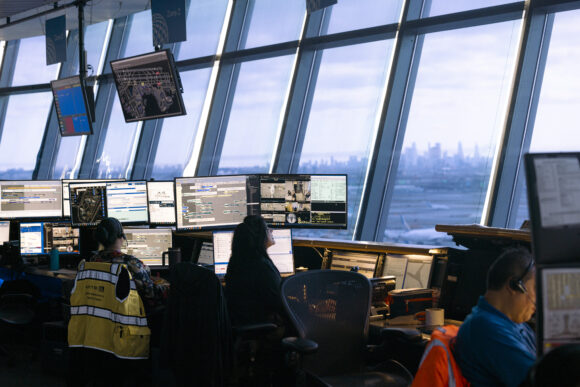A failed backup telecommunications line led to a recent 90-second radar and radio outage that left air traffic controllers unable to see jetliners heading into Newark airport.
After the primary connection that carries radar data into the Philadelphia facility where controllers guide planes into the busy hub failed, a second line to provide redundancy “did not kick in like it was designed to do,” Franklin McIntosh, deputy chief operating officer for the Federal Aviation Administration’s Air Traffic Organization told a Senate panel on Wednesday.
That triggered a 90-second radar outage at the facility, he said. The FAA has since taken steps to ensure redundancy, including adding a third communications line.
Related: Americans Hit the Road as Economic Fears Discourage Flying
“We haven’t had a failure to this degree in my memory,” McIntosh said.
The comments shed new light on the recent equipment breakdown that contributed to weeks of snarled flights at Newark Liberty International Airport near New York City. The lack of an effective backup is highly unusual in commercial aviation.
The Philadelphia facility that guides planes into Newark has experienced at least two major telecommunications failures in recent weeks that left controllers temporarily unable to see or communicate with aircraft in some of the most congested airspace in the US. Hundreds of flights have been delayed or canceled since late April as the issues occurred, though disruptions have moderated more recently.
Related: Newark Airspace Breakdowns Examined by FAA, Verizon Task Force
At a separate hearing, Transportation Secretary Sean Duffy said he recently changed a flight booking his wife was scheduled to take through Newark to avoid delays at the airport, denying reports suggesting he did so due to safety concerns.
“I moved her from Newark to LaGuardia, not for safety, but because I needed her flight to fly,” Duffy told the House Appropriations Committee. “Someone had clipped some audio of that and made it seem like I was talking about safety. I fly out of Newark all the time.”
Duffy continued to lay blame for the technology failures on the Biden administration, which moved oversight of Newark’s airspace from a site in New York state to Philadelphia last summer. The communications lines were not tested and “hardened” when the move took place, and additional outages occurred in October and November, he told the panel.
Crown Castle Inc. and Verizon Communications Inc. provide telecommunications to the FAA’s Philadelphia site, McIntosh said. The FAA is working with Verizon to install fiber optic lines to carry data between Newark airport and the Philadelphia air traffic control site. Duffy said the new infrastructure is being tested now and indicated it is expected to come online this summer.
“We’re working at lightning speed and pace to get this resolved in Newark,” he said.
The breakdowns and disruptions affecting Newark have amplified calls to modernize the country’s system that oversees 45,000 flights carrying about 3 million people each day.
Duffy last week released a broad proposal to overhaul air traffic control, including the construction of new air traffic control centers while replacing old radar and other aging equipment. The effort needs tens of billions of dollars in funding from Congress.
The FAA has also announced short-term steps to address immediate needs at Newark, including technology improvements and boosting staff levels at the Philadelphia facility. Duffy has said he hopes for all of the Newark upgrades to be completed by this summer.
Read More: United Air Warns Flyers of Reduced Newark Service Through Summer
At the same time, the FAA is meeting Wednesday with airlines to discuss further flight reductions at the busy airport. United Airlines Holdings Inc., which accounts for the majority of flights at the hub, has already cut 35 daily round trips and expects at least some additional reductions in the near-term.
Top photo: Workers in the United Airlines Station Operation Center at Newark Liberty International Airport in Newark, New Jersey, on Tuesday, March 19, 2024. Photographer: Angus Mordant/Bloomberg.
Was this article valuable?
Here are more articles you may enjoy.


 Tesla Drivers Are Buying Escape Tools and Cars to Avoid Getting Trapped Inside
Tesla Drivers Are Buying Escape Tools and Cars to Avoid Getting Trapped Inside  Twice Injured Firefighter Loses Second Workers’ Compensation Claim
Twice Injured Firefighter Loses Second Workers’ Compensation Claim  Marijuana’s Move to Schedule III: What it Really Means for Cannabis Insurance
Marijuana’s Move to Schedule III: What it Really Means for Cannabis Insurance  Waymo to Update Software Across Fleet After Major Power Failure
Waymo to Update Software Across Fleet After Major Power Failure 